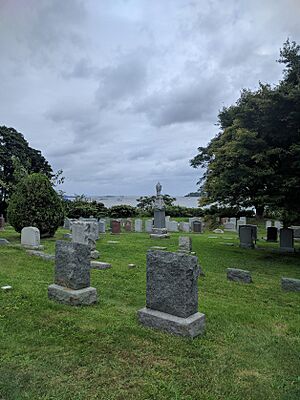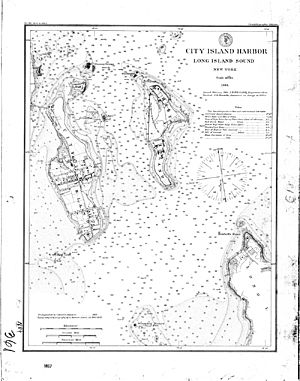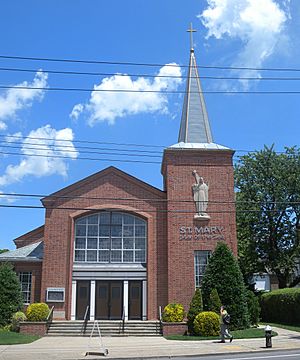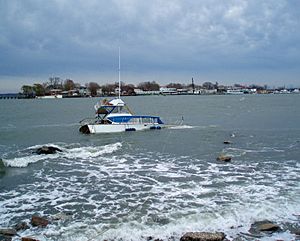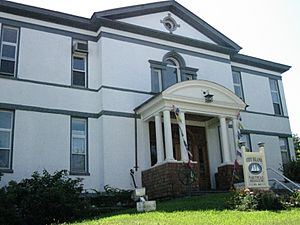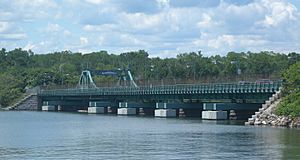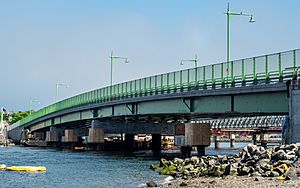City Island, Bronx facts for kids

Aerial view of City Island (left) and Hart Island (right)
|
|
| Geography | |
|---|---|
| Location | Long Island Sound |
| Coordinates | 40°50′53″N 73°47′10″W / 40.848°N 73.786°W |
| Archipelago | The Pelham Islands |
| Area | 0.39505 sq mi (1.0232 km2) |
| Length | 1.5 mi (2.4 km) |
| Width | 0.5 mi (0.8 km) |
| Administration | |
| State | |
| City | New York City |
| Borough | The Bronx |
| Community District | The Bronx 10 |
| Demographics | |
| Population | 4,417 (2020) |
City Island is a unique neighborhood in the northeastern Bronx, New York City. It sits on an island about 1.5 miles (2.4 km) long and 0.5 miles (0.8 km) wide. You can find it at the very western end of Long Island Sound, south of Pelham Bay Park.
This island was once part of the town of Pelham in Westchester County, New York. However, it became part of New York City in the late 1800s. City Island is one of the Pelham Islands, a group that used to belong to Thomas Pell. East of City Island is the smaller, empty Hart Island, with City Island Harbor in between. The Stepping Stones Light, a lighthouse, is off City Island's southern tip.
In 2020, about 4,417 people lived on City Island. The island covers about 0.395 square miles (1.02 km2) of land. It's part of Bronx Community Board 10 and its ZIP Code is 10464.
Contents
History of City Island
Before Europeans arrived, Native Americans lived on City Island. They were likely the Wiechquaeskeck people, part of the Lenape tribe. They left behind piles of shells, showing they ate a lot of oysters and clams. In 1654, an English doctor named Thomas Pell gained ownership of a huge area, including the island.
In 1761, Benjamin Palmer bought the island. It had many names before, like Minnewits and Minefer's. Palmer wanted to turn it into a major seaport for western Long Island Sound. He renamed it New City Island, later just City Island.
At that time, only a few homes and farms were on the island. Palmer dreamed of a busy port with shipyards and stores for passing ships. He even had the island mapped out for different uses like shipyards, docks, and homes. Palmer received a special permission, called the "Palmer Grant," from the British Crown. This grant gave him ownership of the waterfront land 400 feet (120 m) out from the shore. This unique grant has been challenged in court but always upheld.
Palmer's big plans didn't happen because of the American Revolution. The war stopped all progress and used up his money. It took another 60 years for the island to grow. Then, oystermen, boat pilots, and shipbuilders started new businesses there.
In 1819, City Island joined the town of Pelham. In 1895, people on the island voted to become part of New York City. In return, they got a new bridge to the mainland. By 1898, it was officially part of the Bronx. City Island became known for shipbuilding and later as a place for day trips. It still feels like a quiet, suburban area.
There's a fun local tradition: if you were born on City Island, you're called a "clam digger." If you live there but weren't born there, you're a "mussel sucker."
People and Life on City Island
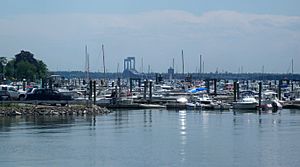
City Island is part of a larger area called Pelham Bay-Country Club-City Island for census records. In 2020, City Island itself had 4,417 residents.
The people living in this area are a mix of different backgrounds. Most residents are adults, with many between 25 and 64 years old. The average life expectancy here is about 81 years, similar to other parts of New York City.
Compared to the rest of the Bronx, Community District 10 (which includes City Island) has a higher income level. This means fewer people struggle to pay their rent.
What's on City Island?
Most businesses on City Island are along City Island Avenue. You'll find a small supermarket, a gas station, a bank, and other shops. The island is most famous for its many seafood restaurants and antique stores.
At the southern end of City Island is Belden Point. It's named after William Belden, who opened an amusement park there in 1887. Long ago, rich people like J.P. Morgan visited this area for fun. Today, Belden Point has many popular seafood restaurants. A new public park opened there in 2016.
In 1960, City Island was the last place in New York City to get dial telephone service. Before that, eight operators in a house connected all calls!
How City Island Was Formed
City Island was shaped by glacial deposits when the last ice age ended. It has layers of rock, red clay, sand, and topsoil. The southern part even has rare blue clay. You can see large rocks left behind by glaciers.
Wildlife on the Island
The animals on City Island are similar to those in other suburban areas. You might see raccoons, squirrels, rabbits, and even deer sometimes.
City Island is a great place for birdwatching, especially for water birds. Many types of ducks live here, along with Canada geese, mute swans, and great blue herons. A small protected wetland on west Ditmars Street is home to many of these birds.
Bright green parrots (monk parakeets) are also common. They were once pets but now live and breed freely in New York. You might also spot wild turkeys in nearby Pelham Bay Park.
Fun Things to Do
Local Sights
City Island is famous for its seafood restaurants. Lobster is a favorite dish. There are over 30 places to eat, from fast food to fancy spots. Most restaurants are open all year.
The City Island Nautical Museum shows off old maritime items. It's at 190 Fordham Street and is open on weekend afternoons. The museum is in the old Public School 17 building, which was built in 1897.
You can also see historic buildings like the Samuel Pell Mansion on City Island Avenue. Parts of the movie Arsenic and Old Lace were filmed there. Many old Victorian mansions with towers and porches are found on the island, especially on the Sound side.
The City Island Theater Group, started in 1999, puts on plays throughout the year.
Boating and Water Fun
City Island has three yacht clubs on the Eastchester Bay side: the Harlem Yacht Club, the City Island Yacht Club, and the Morris Yacht and Beach Club. There are also several commercial marinas.
Many boats are anchored or moored around the island. There are also docks where boats can be securely tied up. Large piers can even receive big ships.
The Columbia University Sailing Team practices here, and their boats are at the City Island Yacht Club. The Fordham University Sailing Team sails from Morris Yacht and Beach Club. Many boats that won the America's Cup were built at the Nevins Boat Yard on City Island.
You can take fishing trips on "head boats" into Long Island Sound. Smaller boats are also available to rent.
Local Groups
City Island has many active community groups:
- City Island Civic Association
- American Legion - Leonard H. Hawkins Post 156
- Cub Scouts Troop 211
- Boy Scouts Troop 211
- City Island Nautical Museum
- Garden Club of City Island
- U.S. Coast Guard Auxiliary Flotilla 014-05-04 City Island
- City Island Little League
- City Island Oyster Reef, Inc
The Island Current
The Island Current is a local newspaper that comes out once a month. It started in 1971 and covers local news, events, businesses, and boating information.
Important Services
City Island has its own fire department, FDNY Engine Co. 70/Ladder Co. 53, located on Schofield Street.
The United States Postal Service has a post office called City Island Station on City Island Avenue. The island's ZIP Code is 10464.
Education on City Island
Most adults in Community District 10 (including City Island) have at least a high school education. Many also have some college education or a college degree.
For elementary school students, about 21% miss 20 or more days of school each year. For high school students, about 75% graduate on time.
Schools on the Island
The public school on City Island is PS 175, located on City Island Avenue. It serves students from kindergarten to 8th grade.
The School of St. Mary Star of the Sea was a Catholic school for grades PreK-8. It closed at the end of the 2012–2013 school year.
The old Public School 17 building now holds the City Island Historical Society and Nautical Museum. It became a historic place in 1984.
Library
The New York Public Library has a branch on City Island at 320 City Island Avenue. It opened in 1903 and moved to its current building in 1970. The library has a special collection of over a thousand items about ships and City Island's history.
Places of Worship
You can find several churches and a synagogue on City Island:
- Saint Mary Star of the Sea Holy Roman Catholic Church
- Trinity United Methodist Church
- Grace Episcopal Church
- Temple Beth El (founded in 1934)
Getting Around City Island
A small rope ferry connected City Island to the mainland starting in 1760. In 1873, a bridge was built. This was replaced by a steel bridge in 1901. In 2017, a new City Island Bridge opened. A temporary bridge was used while the new one was being built.
There's also a small, private bridge connecting City Island to High Island. This island has radio transmitters for WFAN (660 AM) and WCBS (880 AM). It's a private area, so the public cannot access it.
Long ago, from 1887 to 1919, a railway called the Pelham Park & City Island Railway connected City Island to Pelham Bay Park. It even had a monorail for a short time!
Today, you can get to City Island by bus. The MTA Regional Bus Operations's Bx29 local bus goes to the Pelham Bay Park station subway. There are also two BxM8 express bus trips during rush hour that go to Manhattan.
Some people want a NYC Ferry stop on City Island to help with traffic. However, the ferry service currently has no plans to expand there.
City Island in Movies and Books
Films
Many movies have been filmed on or around City Island:
- Richard III (1912), one of the oldest American feature films, was shot in a City Island studio.
- The movie City Island (2009), starring Andy García, is set and filmed on the island. It won an award at the Tribeca Film Festival.
- Butterfield 8 with Elizabeth Taylor.
- Long Day's Journey into Night (1962), with Katharine Hepburn.
- Awakenings, with Robert De Niro and Robin Williams.
- Love Is All There Is, with Angelina Jolie.
- A Bronx Tale, with Robert De Niro, showed the City Island Bridge and a scene at Johnny's Reef Restaurant.
- Don't Say a Word was filmed near Hart Island.
- Wes Anderson's The Royal Tenenbaums was filmed at Delmours Point, a mansion on the island.
- The Groomsmen (2006), directed by Edward Burns, used many City Island locations.
- Margot at the Wedding (2006), starring Nicole Kidman, was filmed on City Island Avenue.
- Michael Douglas and Danny DeVito filmed Solitary Man (2009) at the City Island Diner.
- Jessica Alba filmed An Invisible Sign of My Own (2009) here.
- The documentary Weiner (2016) includes a scene from a meeting on City Island.
Literature
- James Gregory Kingston's novel, The City Island Messenger, is set on City Island during World War II. It's about a boy delivering telegrams with sad news about soldiers.
- In Kurt Vonnegut's novel Bluebeard, a character mentions his yacht was docked on City Island.
- William Fisher's 1952 novel, The Waiters, is about workers at a large seafood restaurant on City Island.
- In Holly Black's Ironside, characters go to City Island to reach Hart Island.
Television
Many TV shows have featured or filmed on City Island:
- Car 54, Where Are You?
- Comedian Jerry Seinfeld visited City Island Diner with Ricky Gervais in his show Comedians in Cars Getting Coffee.
- Coronet Blue
- The Law & Order episode "Maritime" showed the City Island bridge.
- The Law & Order: Criminal Intent episode "Sound Bodies" was based on a true story of teenagers who drowned near City Island.
- The Law & Order: Special Victims Unit episode "Melancholy Pursuit" partly takes place on City Island.
- The series finale of the US version of Life on Mars was filmed on City Island.
- The Amazon series Sneaky Pete filmed on City Island during its first season.
- An episode of Sesame Street from 1976 was filmed here.
Production Company
Since 2002, the film company Harrington Talents has had its offices and studio on City Island. Famous people like rapper Ice-T have worked on their projects.
Famous People From City Island
Many notable people have lived on City Island:
- Anthony Amato (1920–2011) and Sally Amato (1917–2000), who started the Amato Opera.
- Harry Carey (1878–1947), an early silent film star.
- Adolfo Carrión Jr. (born 1961), a former Bronx Borough President.
- Clinton Leupp (born 1965), a drag performer and actor.
- Bruce McRae (1867–1927), a silent film actor.
- George Meany (1894–1980), a famous union leader.
- Henry B. Nevins (1878–1959), a master yacht builder.
- Red Buttons (1919–2006), a comedian and actor.
- Oliver Sacks (1933–2015), a writer who often swam around the island.
- Eric W. Sanderson, an ecologist and author.
- Richard Waring (1911–1994), a television and film actor.
Images for kids


